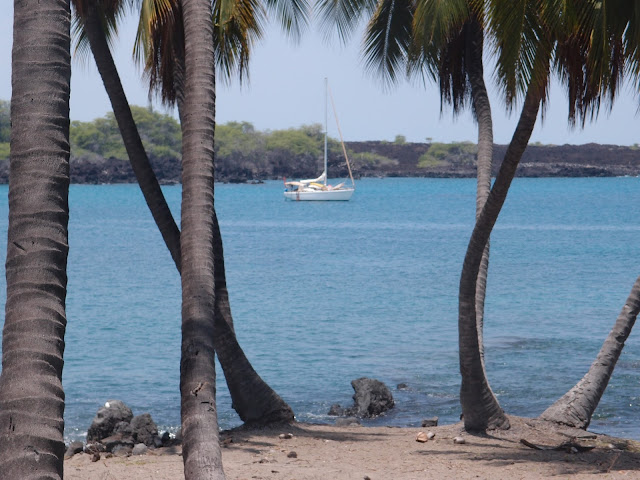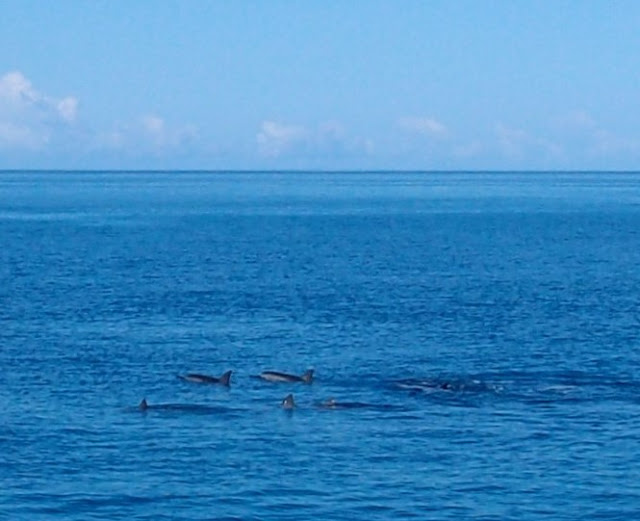 |
| A squall heads our way near sundown. |
Time. You can cross an ocean going little more than five knots, it just takes time. For us in
Oceanus it took just under 22 days to sail from San Jose del Cabo, Mexico, to Hilo, Hawaii -- 2731 nautical miles.
We sailed through four time zones. Most of the time, in fact, we didn't know what time it actually was. It reminded me of the line in
Where the Wild Things Are where Max sailed his boat "in and out of weeks and almost over a year." The clock on the wall in the salon read one time, the satellite clock reported another time, our InReach satellite texting device told another time and the Garmin GPS gave yet another time. To top it off, part way through the crossing the battery for the wall clock over our bunk slowly died adding to the confusion. I began to rely on sunrise and sunset to keep me oriented. The question prompted, what seemed like, hours of discussion between Virginia and me. But we had plenty of time. It wasn't until Hilo hove into view and we picked up a signal for our cell phone, when the issue was settled.
We left San Jose del Cabo on May 21 at about 2 p.m. Mountain Standard Time. Since arriving in California back in February, we traveled a surprising distance east in addition to our steady progress south. So far east, in fact, we added about five days to our ocean crossing. Leaving from San Francisco, the distance to Hawaii is about 2050 miles. Leaving from the tip of Mexico's Baja peninsula added more than 650 miles to the trip even though we were only two degrees of latitude north of Hilo.
Our course was due west and the winds blew out of the northwest putting
Oceanus on a close reach for the first couple of days. The boat moved along well, but it heeled over about 15 degrees making life aboard difficult. Moving about usually took both hands and good timing. Sleeping meant making a nest of pillows on the lee side of the bunk and hoping the boat didn't pound too much in the large seas we encountered. Virginia described it as trying to sleep on a waterbed with a group of three-year-olds jumping on it while beating on pots and pans. I didn't think it was that bad, but I can sleep through almost anything.
It wasn't until day six, we were able to ease the sheets a bit. With the wind on our beam the heeling and pounding was less, but where were the glorious, downwind runs other sailors talk about who experienced the trade winds? Still, beam reaching has its advantages. We racked up some impressive noon-to-noon runs: 150, 157, and 153 nautical miles all with a reefed mainsail and genoa. Then, about day 13, the wind came from the east, northeast and dropped to seven or eight knots. We dropped the main, which was blanketing the genoa, poled out the genoa and raised our reaching staysail, sheeting it on the side opposite the genoa. With wind from the stern, our noon-to-noon milage dropped, but life aboard was much more comfortable.
During the whole voyage we saw only four ships and one other sailboat. We encountered the ships early on as we crossed the route from the Panama Canal to North American ports. We caught a glimpse of a sailboat at the edge of the horizon near the end of the voyage. Except for those encounters, we saw little more than sea and sky.
From on deck I can see about four miles in any direction to the horizon. This movable bubble of sight was our world. The sea teamed with flying fish.
Oceanus startled large schools of them that would leap free of the water and fly above the wave tops. They were a constant source of entertainment. Each day I would pick up two or three that landed on our deck and died there. Only twice did one land in the cockpit so I could return it to the ocean before it died. In the sky, blue-footed boobies regularly visited us circling
Oceanus looking for a place to land. Nothing suited them, and they let us know of their displeasure with squalks and baleful looks. There were shearwaters too, but not many other birds live the pelagic lifestyle required this far from land. Only once did dolphins visit us, but the pod of two or three dozen stayed with us for three hours, playing in our bow wave and breaching.
The sea and sky were our constant companions. No words can adequately describe the beauty of the tropical ocean. I never grow tired of looking at its deep sapphire blue with brilliant turquoise highlights that turns to black as the sun sets. Like the sea, the sky is always changing: the endless variety of cloud formations, the quality of light from each unique sunrise and sunset, and night skies filled with stars. The Milky Way looked like a river of light in the sky most nights. We also saw several meteors, sometimes two or three in a four-hour night watch. Mirroring the lights in the sky was the twinkling phosphorescence in the sea. The vikings called it Ran's jewels after the Norse goddess of the sea. And so it seemed to me -- lights glittering like jewels in the deep.
The wind never got much above 25 knots during the whole passage. Even the occasional squall that came our way didn't pack much of a punch. But the gusts were usually from another direction, throwing off our wind vane self-steering. Little rain accompanied the squalls either. We planned to catch rain. Lucky for us our 120 gallons of fresh water was more than adequate.
 |
| Maid Marian, our Hydrovane self-steering gear worked great, we hardly had to touch the wheel. |
Our third crew member,
Maid Marian, our Hydrovane self steering, worked tirelessly keeping us on course for days at a time without needing any attention. Hydrovane is made in Nottingham, England, so she needed a name from the Robin Hood legend. She's an amazing piece of gear and doesn't complain or need much attention. When the winds were really light, say below three or four knots, she would take a break from her duties and we would hand steer.
Besides our VHF radio, which has a range of only several miles, we had a DeLorme InReach. It uses the satellite phone network to send and receive texts from nearly anyplace on earth. It also sends out a tracking ping every few minutes to update our position on their web site. This is our only long-range communication while at sea. We would occasionally send and receive texts from our family and one friend who kept an eye on the mid-ocean weather for us.
Virginia received a text about half way through the passage telling her that her dad died. He was not in good heath, but it was still tough on her. The funeral was six days before we made landfall. A few days after the funeral, and still about 300 miles from Hilo, I ask Virginia if I could get her anything. "Yes," she said. "Off this boat!" I wasn't sure how to respond, except to say she had to wait or she had a very long swim ahead of her.
With only a few days until our landfall, the focus of our discussions shifted from "What time is it really?" to "What do you want to do once we get to Hilo?" Not surprisingly, for those who know us, it was mostly about food. Specifically: Ice cream and donuts (Virginia); shave ice and fish and chips (Brandon). We both agreed it would be nice to sleep more than four hours in a row on a bunk that didn't bounce around.
 |
| This sailor needs a shave and a shower. |
Things break on a long passage. That's just the way it is. They also always break -- always -- in the middle of the night. Our radar reflector chafed through the flag halyard and fell from spreader height at 1 a.m. It hit the deck right above my head when I was fast asleep. A few nights later a bolt came loose on the boom brake and again it hit the deck right above my head while I was fast asleep.
Some of the things that broke I could fix, but the alternator wasn't one of them. We discovered it wasn't charging the first time we ran our engine. We decide to run the engine once a week to make sure it was working and to fully charge up our battery banks. Our solar panels usually keep the batteries charged unless it's really hot, which taxes our refrigeration, or overcast during the day, which cuts the efficiency of the panels. When that happens, our over-sized alternator on the diesel engine keeps the batteries topped up. Without the help of the alternator, we turned everything off that we didn't absolutely need. We even turned the freezer off at night to conserve electrons.
By 1 a.m., June 10, we could see the lights of Hilo on the horizon.
Oceanus charged along at 6.5 knots. We didn't want to enter the harbor in the dark, so I hove to for about three and a half hours, making about half a knot to the north away from Hilo. As the sky grew brighter I changed course back toward our goal, but by then the wind was light and fluky, coming directly from where we wanted to go. Our batteries were too low to start the engine and the overcast day wasn't helping. In desperation, I lashed our Honda 2000 portable generator to the deck, crossed my fingers, and fired it up.
We use the Honda as needed to top up our batteries while in calm anchorages. I wasn't sure it would work at all on the pitching deck while underway. But it worked like a champ, charging the batteries while Virginia and I fought to keep
Oceanus moving in the light and unpredictable breeze. By noon the batteries were still low but we decided to try the engine. It cranked, but didn't catch. I tried again, still no love. One last time. Crank, crank, crank, sputter, crank, sputter, sputter, vrooom! Hilo and ice cream, here we come! It's about time.
 |
| The view from Oceanus safely anchored in Reed's Bay, Hilo, Hawaii. |
The Aquarium connection
The Oregon Coast Aquarium is following our adventure on their web site as part of the Oceanscape Network. If you would like to read more about our encounters with marine wildlife look
here.
If you want to track us go to share.delorme.com/virginiaford.























































